You are here
Spotlight on the Bronze Age!
The institut national de recherches archéologiques préventives (national institute for preventive archaeological research) is dedicating its ninth scientific and cultural season to the Bronze Age. Long relegated to an obscure period of Protohistory, it has revealed its true face under the spotlight of preventive archaeology: that of metallurgy, which saw agricultural societies engage in commercial exchanges throughout Europe and access an early form of complex economy. Throughout 2025, Inrap and its partners are getting into the Bronze Age with a rich program of cultural and scientific events.
The Bronze age in France
Between the "Neolithic revolution" (6000 to 2300 BC) and the Iron Age (800 BC to the end of the 1st century BC), the Bronze Age has, in recent years, been the subject of new approaches thanks to preventive archaeology operations set up by the 2001 french law. More than 3,500 diagnostic reports and 1,300 excavation reports from the Institute have revealed remains from the Bronze Age (not including Campaniform remains, which are situated between the Neolithic and Bronze Ages), which profoundly renew the perception of a period, known until now mainly for its metal deposits and and a few exceptional megalithic or palafittic sites (pile dwelling sites). Many of these excavations are extensive operations which have allowed spatial approaches to territory and terroirs, forms of habitat, funerary contexts or agrarian systems.
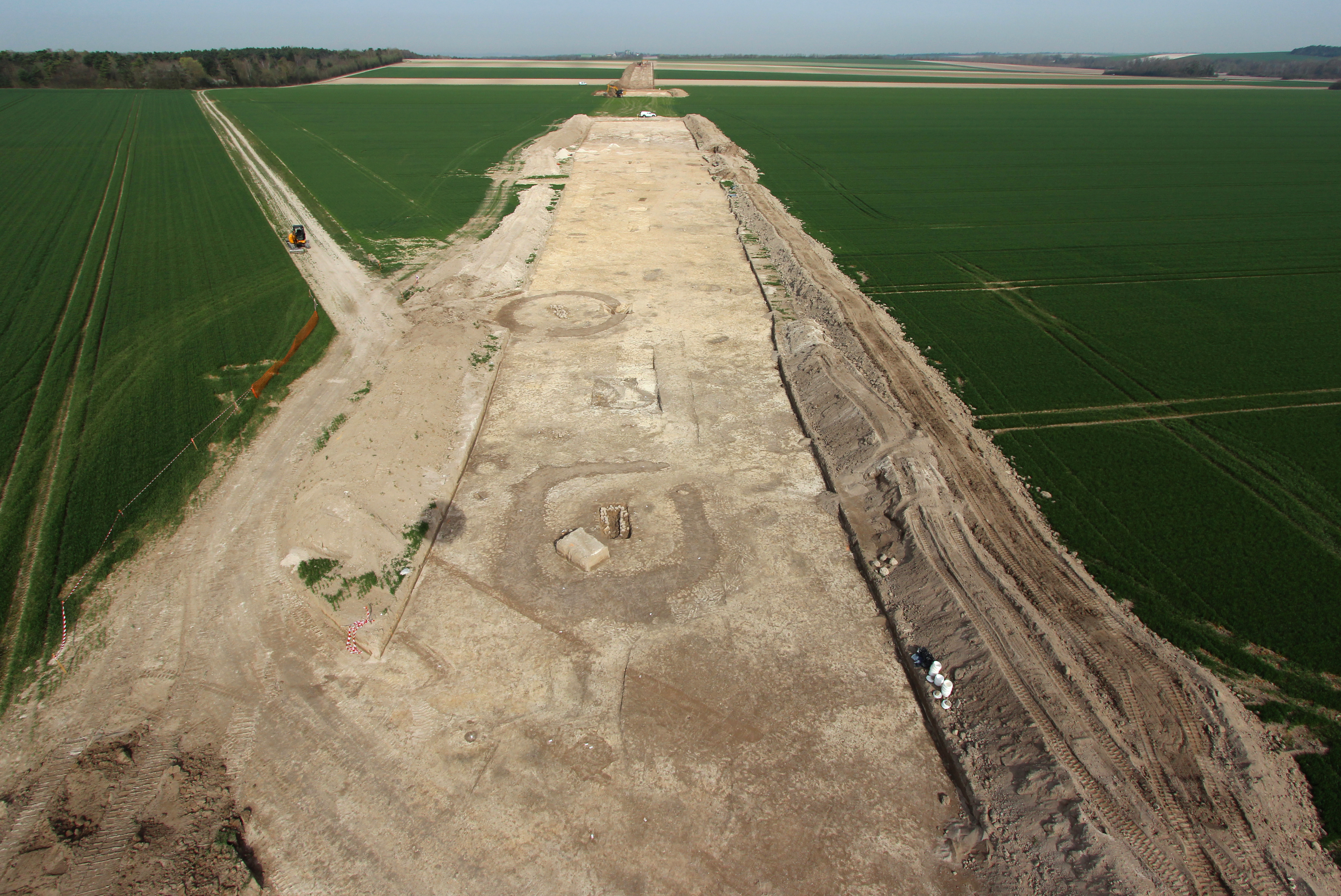
Protohistoric necropolis of Marigny-le-Châtel (Aube). Excavations of the Arc de Dierrey, 2014. The extent of the necropolis is such that it required three archaeological excavations in three different points. The darker square and circle visible here correspond to the ditches which demarcated the funerary space dedicated to a person and which was to be topped by a monument.
© F. Canon, vertical photo
Conducted on a local scale and integrated into a major national survey carried out by Inrap since 2007 (see Recherches archéologiques, 12, 2017), this new research has highlighted the strong dynamics of settlement, particularly at the end of the Bronze Age (from the 14th century BC onwards). It has also enabled us to gain a better understanding of building clay, a fleeting and disparate vestige, but the basis of many buildings and craft activities. Present throughout the Bronze Age, the isolated family farm, erected on load-bearing posts and surrounded by agricultural plots, constitutes the basic element on which more complex forms of habitat developed (Ancenis, Buchères, Sartène...), followed by full-fledged villages (Malleville-sur-le-Bec, Caudan).
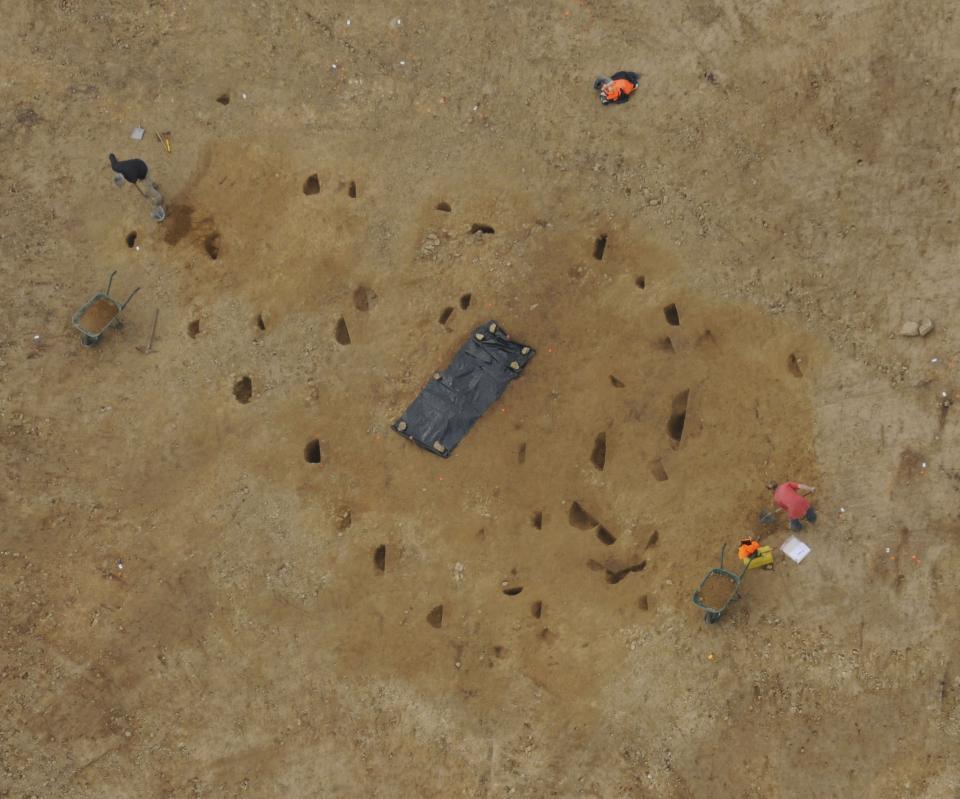
Zenithal view of a Bronze Age house, around 1000 BCE, unearthed in Caudan, in Morbihan. On this site, nearly twelve buildings erected on wooden posts were discovered. The plans are those of a round house, preceded by a porch.
© Hervé Paitier, Inrap
Small-scale animal-drawn agriculture (whose origins were long attributed to the late Iron Age), bronze tools (axe, sickle), the introduction of millet, the development of leguminous crops and intensive polycultures, all bear witness to a new agricultural “revolution”, following that of the Neolithic. The most recent studies also emphasize the decisive role played by the Bronze Age in enriching biodiversity. The impact of farming, but also of forestry and mining activities, has left a lasting mark on the landscape, even in hitherto relatively untouched environments, such as in the high mountains with the exploitation of copper mines, or in the mid-mountains with the development of agro-pastoralism, while a structured network of roads and land parcels has been established in certain regions. Coastlines, deltas, valleys and lagoons were also highly dynamic environments in which economic activities developed, thanks to innovations in the design of boats.
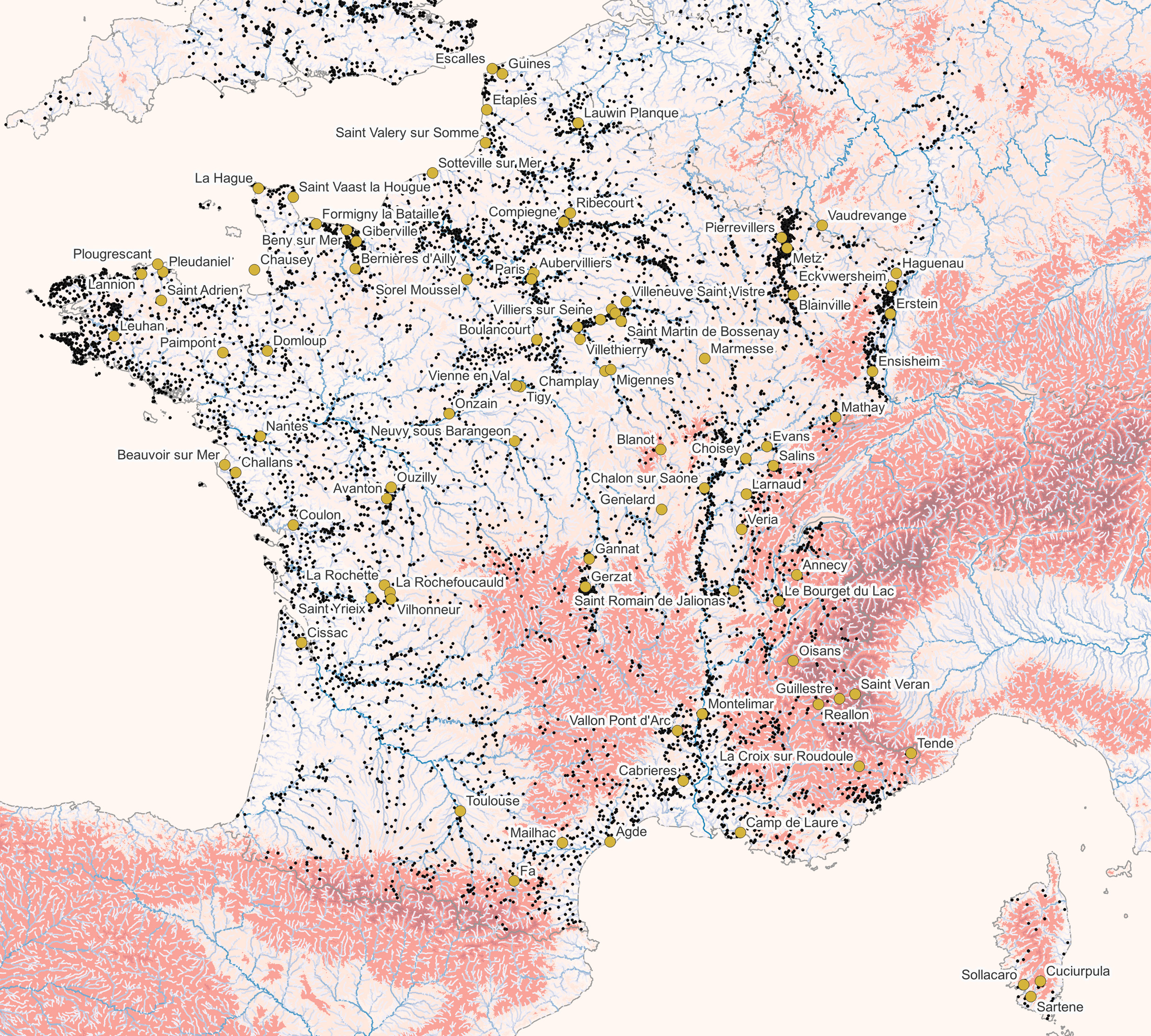
Bronze Age sites excavated in France by Inrap.
© Cyril Marcigny, Inrap
Bronze metallurgy, an alloy of copper and tin (from 2300 BC), is one of the most structuring innovations in the economy, political relations and society of the period. Since natural resources in copper and tin ores were very unequally distributed in Europe, exchange became a necessary condition for obtaining the precious metal, which could be accumulated and recycled endlessly. New trade networks developed by land, river and sea, over medium and long distances throughout Europe, allowing a dense circulation of people and goods (copper and tin, silver, salt, amber, furs, glass...), as well as cults (sun, moon, stars, animals or emblematic characters,…), funeral rites (such as cremation), ideas and craft skills.
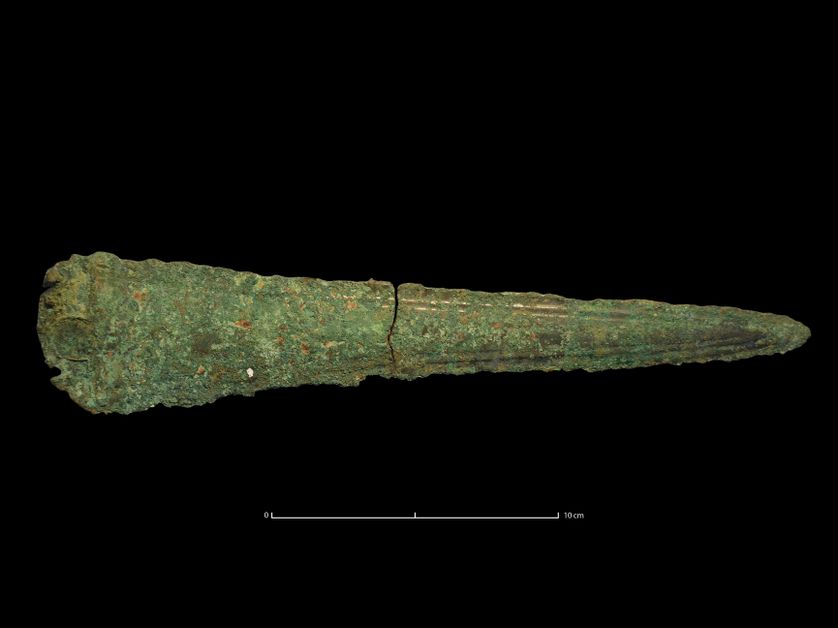
Bronze dagger found in the princely tomb of Giberville, dated from the Early Bronze Age (around 1800-1600 BC), with its fixing rivets at the top of the blade.
©Bruno Bell
While an initial production and distribution system was developing, societies themselves evolved towards greater complexity, with more marked hierarchies (chieftaincies) and, if not a “division of labor”, at least an increasing specialization of craftsmen, metalworkers, potters, goldsmiths, carpenters, weavers, etc., for the production and distribution of elaborate objects that could no longer be made in the domestic sphere. Shepherds and peasants who had become more productive generated wealth that participated in these new exchanges.
Less spectacular or “revolutionary” than Neolithization, characterized by the introduction of agriculture and a sedentary lifestyle, “bronzization” (a term proposed by Helle Vandkilde) nonetheless represents a key stage in the construction of our environment, as well as a movement of acceleration of exchanges and global complexity that ushered in our modern societies and a form of “globalization” on a European scale.
By dedicating its scientific and cultural season to the Bronze Age, Inrap intends to highlight hroughout the year a sample of works and events that shed light on the various facets of this period, which is still poorly understood in France and Europe, and whose singularity has been brought to light by preventive archaeology.
On inrap.fr

Throughout the year, the “Bronze Age” season can be followed on inrap.fr, as new research and site discoveries are featured in news articles, reports, multimedia, interviews with archaeologists, podcasts... You can also discover resources made available by museums and major Bronze Age archaeological sites in France and throughout Europe. To keep up with the latest news, visit the Bronze Age Season hub.
CULTURAL Agenda
Exhibitions
- “Masters of Fire. The Bronze Age in France 2300 - 800 BC” (“Les Maîtres du feu. L’âge du Bronze en France 2300 – 800 av. J.-C.”) at the Musée d'Archéologie nationale et domaine national du château de Saint-Germain-en-Laye.

2025 marks the 150th anniversary of the recognition of the existence of a true Bronze Age in France, when Ernest Chantre published his Études paléo ethnologiques dans le bassin du Rhône : recherche sur l'origine de la métallurgie en France (1875). On this occasion, the Musée d'Archéologie Nationale (MAN), the institut national de recherches archéologiques préventives (Inrap) and the Association pour la promotion des recherches sur l'âge du Bronze (APRAB) have joined forces to present a major exhibition dedicated to the Bronze Age, “Les Maîtres du Feu”, from June 13, 2025 to March 6, 2026, at the Musée d'Archéologie Nationale and the Domaine National du Château de Saint-Germain-en-Laye.
In European societies, the introduction of bronze metallurgy and the tremendous impetus generated by the production and use of metal led to real changes in material culture and the imagination. The circulation of goods and people, and the development of means of communication by land and sea, experienced unprecedented growth. Four thematic sections - producing, exchanging, imagining the world, inhabiting the world - will highlight emblematic pieces from MAN's collections and those of French and European museums, as well as recent archaeological discoveries made in France, notably from Inrap excavations.
Exceptional objects will be presented, such as the Bronze situla of Unterglauheim (Augsburg, Römisches Museum), the sword of Pont-sur-Seine (Epernay museum), the slab of Saint-Bélec, the torque of Guînes, the cone of Avanton, but also mass productions such as deposits of axes, objects and ingots (Bény-sur-Mer, Escalles, Guînes, Saint-Valery-sur-Somme, Ribécourt, Jenzat...), cremations (Choisey), a ½ scale replica of the Dover boat, etc.
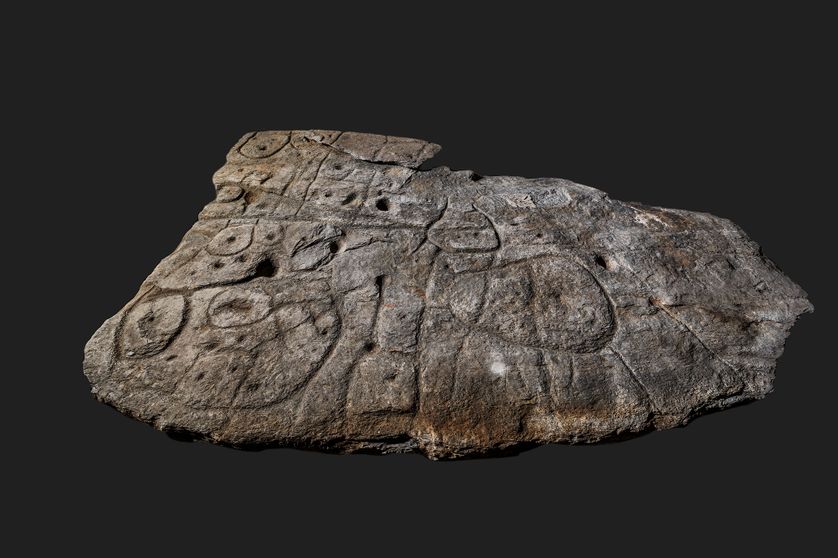
The slab of Saint-Bélec.
© Denis Gliksman, Inrap
Rose-Marie Mousseaux, Director of the Musée d'Archéologie Nationale - Domaine National de Saint-Germain-en-Laye (MAN)
Daniel Roger, Head of the Scientific Department, Musée d'Archéologie nationale - Domaine national de Saint-Germain-en-Laye (MAN)
Dominique Garcia, President, Institut national des recherches archéologiques préventives (Inrap)
Claude Mordant, President of the Association pour la Promotion des Recherches sur l'Age du Bronze (Aprab), Professor Emeritus of European Protohistory at the University of Burgundy.
Rolande Simon-Millot (MAN), curator in charge of Neolithic and Bronze Age collections (Musée d'Archéologie nationale)
Rebecca Peake, archaeological research manager (Inrap)
Cyril Marcigny, Deputy Scientific and Technical Director for the Grand Ouest (Inrap)
Stefan Wirth, Professor of European Protohistory (University of Burgundy)
• Cultivating in the Bronze Age: Archaeo-experimentation in the national domain

In phase with “Les Maîtres du feu”, and still in partnership with Inrap and the Association pour la promotion des recherches sur l'âge du Bronze (APRAB), several areas of the Domaine national de Saint-Germain-en-Laye (45 ha) will be devoted to a presentation of the different crops in use during the Bronze Age: domesticated millet (from China), camelina (Iranian-Anatolian region) or ers (Near East), but also wheat, barley, legumes or oilseeds, acorns, hawthorn, hazelnuts, sloe, apple, rosehip, blackberry, strawberry and raspberry, not forgetting vegetables, leaves, roots and certain textile, dyeing and craft plants (nettle, lime, wicker). A program designed with the AGRO-CAMPUS of Saint Germain en Laye/Chambourcy and Françoise Toulemonde, archaeobotanist.
• "Cuisiner les Restes : 2000 ans d’alimentation avant notre ère" ("Cooking Leftovers: 2000 Years of Food Before Our Era") at the musée-parc archéologique Arkéos de Douai (Nord)
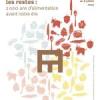
From December 7, 2024 to July 6, 2025, the exhibition presents the methods used to acquire food in the Metal Ages, from hunting to plant cultivation, including product processing, cooking and food preservation. Recent excavations and technological innovations in archaeology make it possible to accurately reconstruct the food practices of these populations.
• “L’Odyssée du Bronze. À la rencontre des premiers européens” (“The Bronze Odyssey. Meeting the First Europeans”) at the Musée Anne de Beaujeu in Moulins (Allier)

As part of the scientific year dedicated to the Bronze Age, the Musée Anne-de-Beaujeu is presenting a major retrospective exhibition on the discoveries of this period made in Allier between the 18th and 21st centuries, from February 8 to September 21, 2025.
Allier already appears to be an economic, cultural and social crossroads. The presence in Bourbonnais of objects made from exotic materials such as Baltic amber, transalpine glass or manufactured objects from the eastern Mediterranean, indicates contacts with very distant areas. At the same time, certain motifs such as that of the solar boat are found in objects discovered in Charroux or La Ferté-Hauterive implying the sharing of beliefs on a European scale. The discoveries made over the past five years as part of the PCR (Collective research program) "The Gannat region (Allier) during Protohistory and Antiquity. From archaeological remains to territorial modeling (2019-2025...)" will be in the spotlight. Several of the exceptional deposits of Jenzat will be presented to the public for the first time with the presentation of unpublished objects discovered since 2020. The National Archaeology Museum of Saint-Germain-en-Laye is lending for the occasion the deposits discovered in Rongères and Jaligny-sur-Besbre and never presented in Allier.
• "Pouvoir et métal; l'âge du Bronze en Île-de-France” ("Power and metal; the Bronze Age in Île-de-France" ) at the Musée de Préhistoire d'Île-de-France (Nemours, Seine-et-Marne)
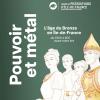
From April 5 to December 30, 2025, the Musée de Préhistoire d'Île-de-France in Nemours is presenting a temporary exhibition on the Bronze Age in Île-de-France in order to introduce this period in a fun and educational way and to present a summary of the most recent archaeological data, some of which come from excavations carried out by Inrap and the Department of Seine-et-Marne.
• "Rites funéraires de l'âge du Bronze” et "Naissance de la guerre à l'âge du Bronze” ("Bronze Age Funeral Rites” and "The Birth of War in the Bronze Age”) at the Musée de Quinson (Alpes-de-Haute-Provence)
From February 1 to December 15, 2025, the Musée de Préhistoire des Gorges du Verdon, which holds a major Bronze Age collection, including the Moriez “treasure” deposit, will present two temporary exhibitions "Rites funéraires de l'âge du Bronze” (February 1 to June 30) and "Naissance de la guerre à l'âge du Bronze” (July 2 to December 15, 2025).
•"Les méandres du passé. Quand la Bresse raconte l'âge du Bronze” (“The meanders of the past. When the Bresse tells the story of the Bronze Age”) at the Écomusée de la Bresse bourguignonne (Saône-et-Loire)

From June 11, 2025 to June 30, 2026, The Écomusée de la Bresse bourguignonne invites you to immerse yourself in the heart of the Bronze Age, a key period in human history, where technical innovations and societal dynamics have lastingly shaped the landscapes and lifestyles of our ancestors.
Through authentic artifacts, exceptionally preserved wooden remains and reconstructions, this exhibition highlights the daily life of Bresse communities several millennia ago. From bronze metallurgy to agricultural and artisanal practices, "The meanders of the past" offers a renewed look at the ingenuity and adaptation of protohistoric societies in the face of the environmental and cultural challenges of their time.
Drawing in particular on the archaeological discoveries of Inrap in Pierre-de-Bresse, combined with an immersive scenography, this exhibition also questions our own relationships with resources and innovation, revealing how the legacy of this ancient era still resonates in contemporary concerns.

Funerary circle, Malleville-sur-le-Bec (Eure).
© E. Mare, Inrap
Conferences
February 8: “Faits de violence du Néolithique à l'âge du Bronze: des rixes intergroupes à l'invention du guerrier” (“Acts of violence from the Neolithic to the Bronze Age: from intergroup brawls to the invention of the warrior”) by Cyril Marcigny, Deputy Scientific and Technical Director, Grand Ouest (Inrap), lecture organized by the Société des amis du Musée d'archéologie nationale (SAMAN) at the Musée d'Archéologie nationale - Domaine national du château de Saint-Germain-en-Laye (78).
April 26: “Les dépôts” (“The deposits”) by Claude Mordant, President of the Association pour la Promotion des Recherches sur l'Âge du Bronze (Aprab), Professor Emeritus of European Protohistory at the University of Burgundy, at the Musée de Préhistoire d'Ile-de-France, Nemours (77).
June 4: “Un site exceptionnel de l'âge du Bronze dévoilé : Jenzat (Allier)” (“An exceptional Bronze Age site revealed: Jenzat, Allier”) by Pierre-Yves Milcent, Professor of Protohistoric Archaeology, Université de Toulouse Jean Jaurès, at the Musée Anne de Beaujeu, Moulins (03).
May 10: “Dover Boat” by Anne Lehoërff, Thierry Biot and Paul Bennett, organized by the Société des amis du Musée d'archéologie nationale (SAMAN) at the Musée d'Archéologie nationale - Domaine national du château de Saint-Germain-en-Laye (78).
June 19: “Le trou de la Licorne, une grotte de l'âge du Bronze” (“The Unicorn Hole, a Bronze Age Cave”) by José Gomez de Soto and Isabelle Kerouanton, at the Musée d'Angoulême (16).
July 3: “Habiter et construire à l'âge du Bronze dans les Charentes et le Poitou (2200-800 av. J.-C.)” (“Living and building in the Bronze Age in Charentes and Poitou, 2200-800 BC)”) by Christophe Maitay, Jonzac (17).
September 13: “Agriculture et alimentation” by Françoise Toulemonde, Ginette Auxiette and Anaïs de Roux, organized by the Société des amis du Musée d'archéologie nationale (SAMAN) at the Musée d'Archéologie nationale - Domaine national du château de Saint-Germain-en-Laye (78).
September 17: “L'invention du guerrier du Néolithique à l'âge du Bronze en Europe occidentale” (“The invention of the warrior from the Neolithic to the Bronze Age in Western Europe”) by Cyril Marcigny, deputy scientific and technical director, Grand Ouest (Inrap), at the Musée de Préhistoire de Carnac (56).
September 27: “Agriculture et alimentation” by Françoise Toulemonde and Rebecca Peake, at the Musée de Préhistoire d'Île-de-France, Nemours (77).
October 1: “La dalle de Saint-Bélec” (“The Saint-Bélec slab”) by Clément Nicolas and Yvan Pailler, at the Musée d'Archéologie nationale - Domaine national du château de Saint-Germain-en-Laye (78).
October 25: “Évolution du terroir” (“Evolution of the terroir” )by Patrick Gouge, at the Musée de Préhistoire d'Île-de-France, Nemours (77).
November 8: “Les dépôts / Jenzat” (“The Deposits / Jenzat”) by Sylvie Boulud and Pierre-Yves Milcent, organized by the Société des amis du Musée d'archéologie nationale (SAMAN) at the musée d'Archéologie nationale - Domaine national du château de Saint-Germain-en- Laye (78).
December 3: “People of the Bronze Age” (“Les gens de l’âge du bronze”) by Valérie Delattre and Rebecca Peake, Musée d'Archéologie nationale - Domaine national du château de Saint-Germain-en-Laye.
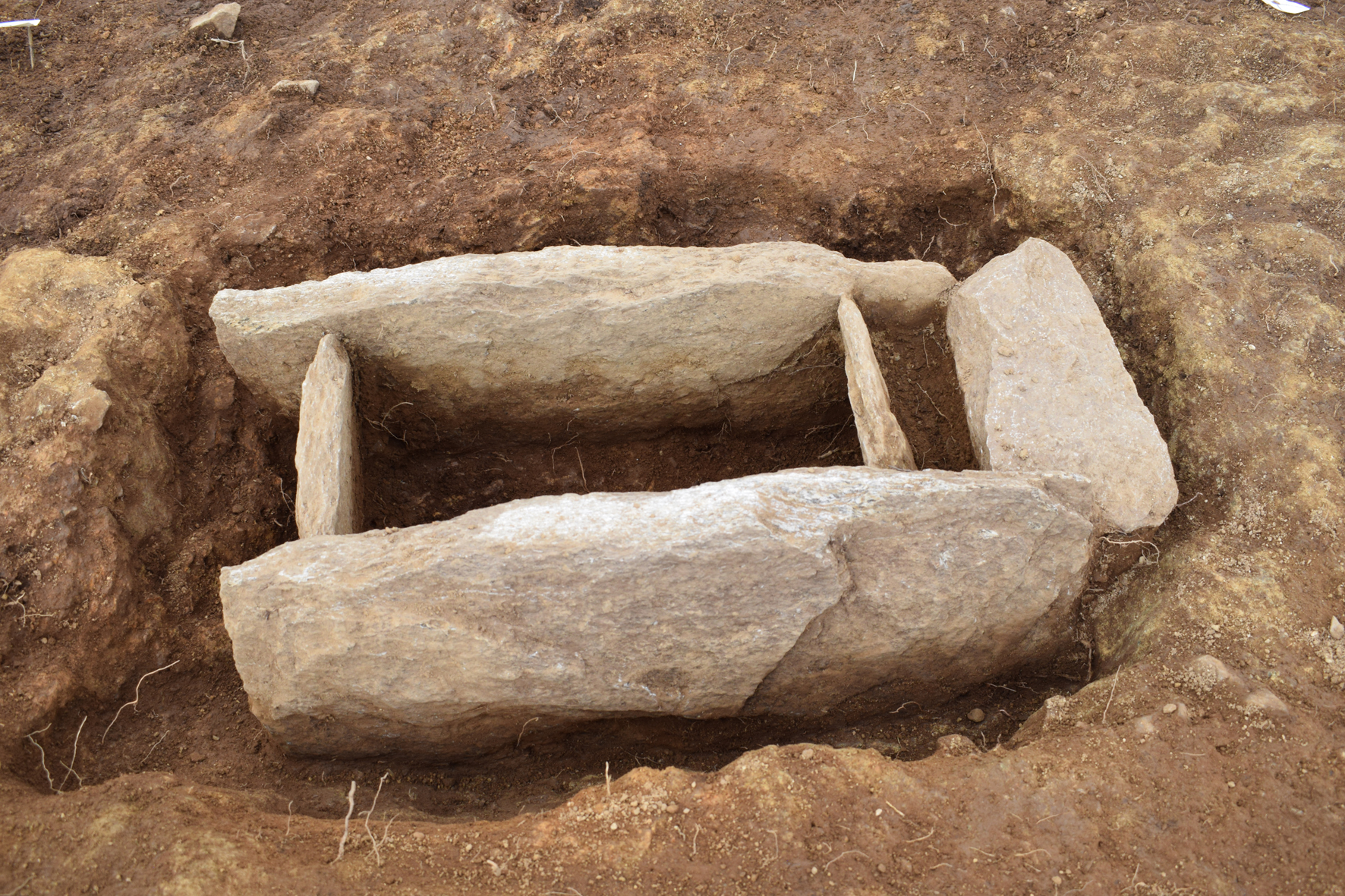
Stone chest tomb unearthed at Plougonvelin (Finistère).
© S. Blanchet, Inrap
European Archaeology Days (June 13-14-15)
As every year, Inrap will contribute to numerous actions on the theme of its scientific and cultural season as part of the European Archaeology Days (JEA) from June 13 to 15, then the European Heritage Days (JEP) from September 20 to 21, 2025.
A part of this 2025 edition of the JEA will be devoted to the archaeo-experimentation of Bronze Age practices: bronze casting workshops, weaving, boat building and navigation, food, etc. Of particular note is the free access to the exhibition "Les Maîtres du feu" and a village of archaeological know-how at the Musée d';Archéologie nationale - domaine national du château de Saint-Germain-en-Laye, which will present a whole series of experiments around Bronze Age agriculture.
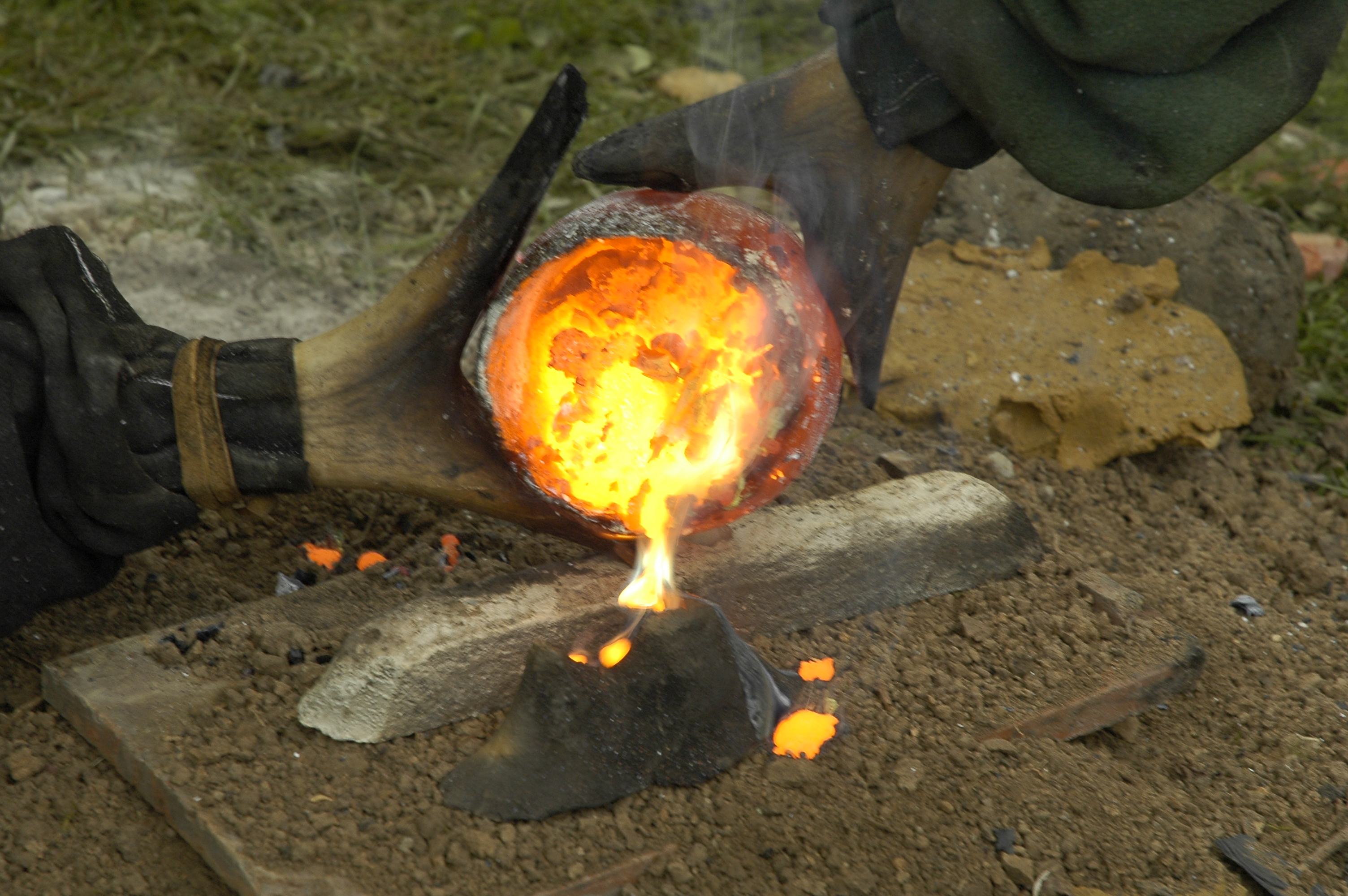
Bronze casting as part of an experimental reconstruction. Here, molten bronze from a crucible is poured into an earthen mold. Experimental archaeology by Jean Ladjadj and his team.
©Nicolas Fromont, Inrap
Scientific Agenda
Meetings, study days
As every year, the Institute contributes to the major cycles of events bringing together archaeologists and historians around the Bronze Age.
• February 28: thematic day of the Association for the promotion of research on the Bronze Age (APRAB) at the auditorium of the National Archaeology Museum - National Estate of the Château de Saint-Germain-en-Laye: "Between archaeology and social anthropology: how to evaluate social complexity in the Bronze Age in Western Europe?"
• March 1: Annual news day 2025 of the Association for the promotion of research on the Bronze Age (APRAB) at the auditorium of the National Archaeology Museum - National Estate of the Château de Saint-Germain-en-Laye.
• March 25-26: “Parures de la Mer. Vogue d'Orient en Occident du Chalcolithique à l'âge du Bronze” (“Sea Ornaments. Sailing from the East to the West from the Chalcolithic to the Bronze Age”), Round Table - Specialized session of the French Prehistoric Society (SPF) in partnership with the Association for the Promotion of Research on the Bronze Age (APRAB), Maison des Sciences de l’Homme et de la Société Sud-Est, Université Côte d’Azur, Nice
• May 18-21: 23rd Archéo & Gobelets conference, “Sea People, Land People: lifestyles and networks in Bell Beaker Europe”, Vannes/Carnac
• October 8-10: “Dessine-moi le passé! de l'étude scientifique a la production d'images du mésolithique a l'âge du bronze (“Draw me the past! from scientific study to the production of images from the Mesolithic to the Bronze Age”), Rencontres Nord - Sud 5, Université de Lille/Le Fresnoy (Tourcoing)

Ceramics, Malleville-sur-le-Bec (Eure).
© E. Mare, Inrap
Research programs 2025
Inrap is supporting several scientific programs on the Bronze Age currently underway or starting this year:
“Le site à dépôts métalliques multiples de l'âge du Bronze moyen 2 et l'occupation domestique du Premier âge du Fer de Kerouarn à Prat (Côtes-d'Armor)” (“The site with multiple metal deposits from the Middle Bronze Age 2 and the domestic occupation of the Early Iron Age from Kerouarn to Prat, Côtes-d’Armor)”, planned search (dir. Marilou Nordez);
“Le dépôt de Bény-sur-Mer (Calvados), Étude et remise en contexte d'un dépôt exceptionnel du Bronze moyen” (“The deposit of Bény-sur-Mer -Calvados, Study and putting into context of an exceptional deposit from the Middle Bronze Age”), planned search (dir. Cyril Marcigny);
“Une étude multiscalaire d'un territoire de l'âge du Bronze : autour du dépôt d'Escalles (Pas-de-Calais) ” (“A multiscalar study of a Bronze Age territory: around the Escalles deposit, Pas-de-Calais)”, planned search (dir. Emmanuelle Leroy-Langelin);
“Dépôts de bronzes et territoires en région salinoise: pratiques de dépôts métalliques à l'âge du Bronze autour des sites fortifiés de Franche-Comté” (“Bronze deposits and territories in the Salin region: practices of metal deposits in the Bronze Age around the fortified sites of Franche-Comté”), collective research project (PCR) (dir. Estelle Gauthier);
“Les jarres et dolia dans l'espace de l'habitat de la fin de l'âge du Bronze à l'aube de l'époque romaine en Champagne” ((“Jars and dolia in the habitat space from the end of the Bronze Age to the dawn of the Roman era in Champagne”), collective research project (dir. Marion Saurel);
“La céramique alsacienne du Bronze final IIIb à La Tène ancienne: 10 ans de données inrapiennes” (“Alsatian ceramics from the Final Bronze IIIb to ancient La Tène: 10 years of Inrapian data”), collective research project (dir. Marieke van Es);
“Les populations de l'âge du Bronze en Ile-de-France. Recherches sur la paléoalimentation et la mobilité : le PCR Bronz'Pal” (“Bronze Age populations in Ile-de-France. Research on paleonutrition and mobility: the Bronz’Pal PCR”) (dir. Rebecca Peake);
“Une nécropole de la fin de l’âge du Bronze moyen et du Bronze final à Eckwersheim Burgweg Rechts” (Bas-Rhin)", (dir. Matthieu Michler) “Late Middle Bronze Age and Late Bronze Age necropolis at Eckwersheim Burgweg Rechts (Bas-Rhin)”, (dir. Matthieu Michler)
“De la tombe au territoire: les pratiques funéraires en Normandie durant l'âge du Bronze ancien et moyen” (“From the tomb to the territory: funerary practices in Normandy during the Early and Middle Bronze Age”), PCR (dir. Cyril Marcigny).
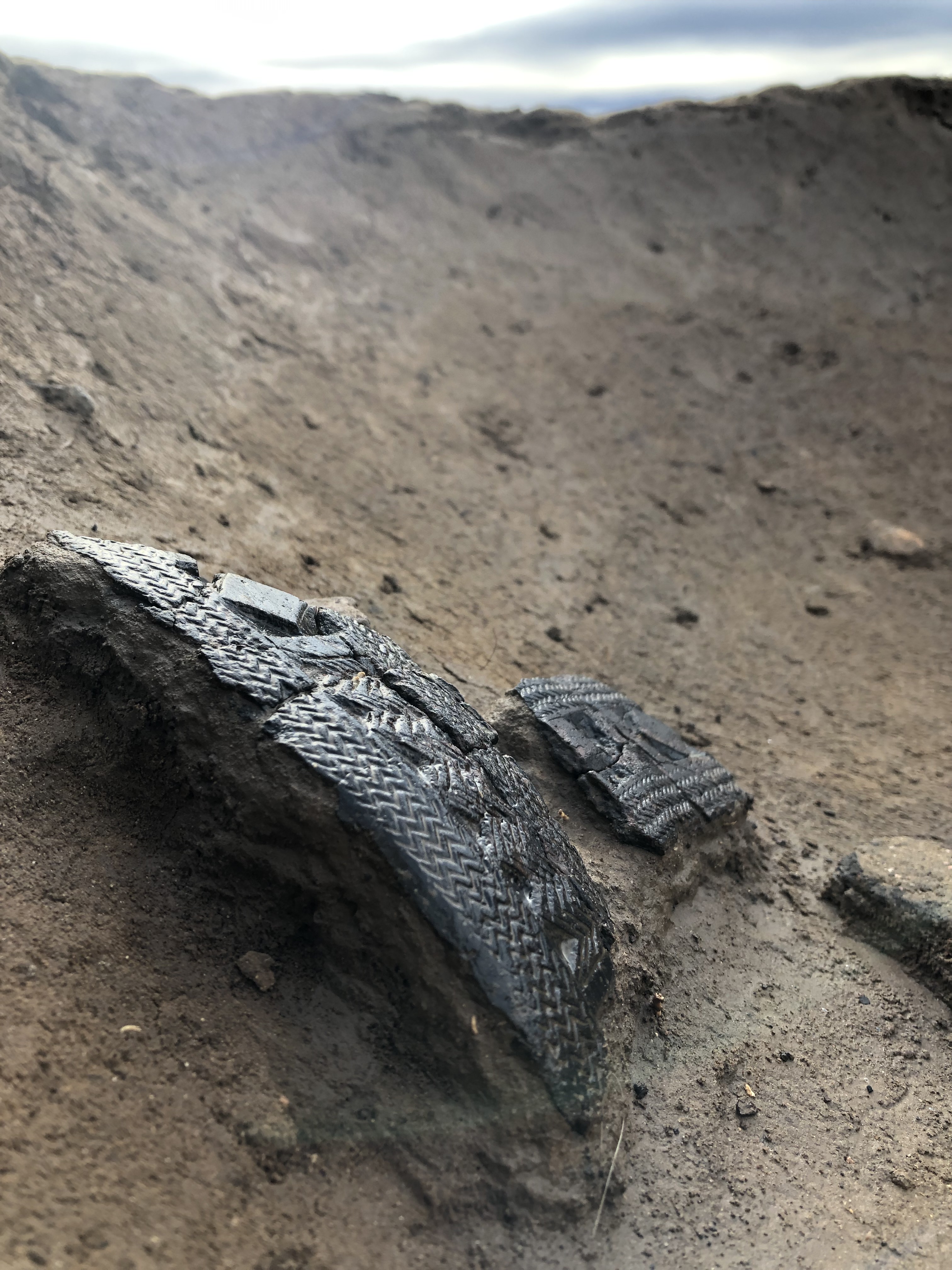
Fragments of Late Bronze Age ceramics (banded incised decoration), discovered on the Mane plain (Alpes-de-Haute- France).
© Inrap/SDA 04

